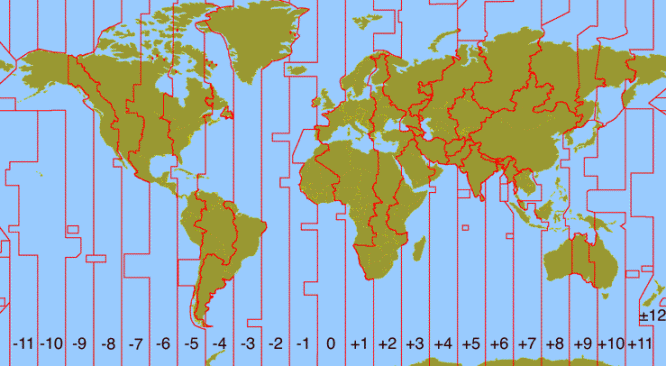Time of Day
|
Apparent Solar Time
 For thousands of years people measured time based on the position of the Sun.
Noon was when the Sun was at its highest in the sky.
Sundials were used as the primary time keeping device. In the Middle Ages
mechanical clocks began to assume the role,
but even then, individual cities and towns would set their large central clocks by the position of the Sun.
For thousands of years people measured time based on the position of the Sun.
Noon was when the Sun was at its highest in the sky.
Sundials were used as the primary time keeping device. In the Middle Ages
mechanical clocks began to assume the role,
but even then, individual cities and towns would set their large central clocks by the position of the Sun.
Universal Time Eventually, as the nations grew, and as telegraphs and railroads quickened communications, people considered the concept of a universal standard for time that was independent of location. The result was the establishing of Greenwich Mean Time in 1880. At the Washington Meridian Conference of 1884, GMT was accepted as the time standard for the world. The local mean time of the prime meridian which passes near the Greenwich Observatory in England is now known as Universal Time. The name replaced the standard known as Greenwich Mean Time in 1928 but they are the essentially the same thing. Universal Time is defined by the rotation of the Earth and therefore is not perfectly uniform. It is the responsibility of the International Earth Rotation and Reference Systems Service (IERS) to measure the Earth's rotation and determine whether the addition of a leap second to the end of a calendar year is necessary to keep our clocks astronomically precise. Local Time Zones tandard Time Zones were established in the U.S. and Canada in 1883 by the railroad companies. The first U.S. Congressional "Uniform Time Act" was passed in 1918, repealed in 1919, re-established during WWII, and updated in 1966. The law allows for local exemptions from its observance. A time zone is approximately 15 degrees wide in longitude, extends from pole to pole, and within it a uniform clock time is used. The borders of the zones accommodate geographical and political regions. Time zones are a measure of the hour angle from your location to the Prime Meridian near Greenwich Observatory in England. The Pacific time zone is 8 time zones, or 120 degrees west of the Prime Meridian. Clocks in Bellingham Washington are therefore 8 hours behind Universal Time (9AM Greenwich = 1AM Bellingham), and 7 hours behind during Daylight Saving Time (9AM Greenwich = 2AM Bellingham). 
Longitude Correction The timing of some astronomical events is affected by an observer's location within a time zone. The center of the Pacific Time Zone is 120 degrees from the Prime Meridian, a difference of -8 hours (-7 for Daylight Savings Time), But the WWU campus is about 2 and 1/2 degrees farther west, a difference of almost 10 minutes. Daylight Time Benjamin Franklin introduced Americans to the idea of daylight saving in 1784 with an essay called "An Economical Project." The main purpose is to make better use of daylight. We change our clocks during the summer months to shift an hour of daylight from the morning to the evening. Daylight Time (aka Daylight Saving Time) begins in the United States on the second Sunday in March and ends on the first Sunday in November. On the second Sunday in March, clocks are set ahead by one whole hour at 2 a.m. local standard time, so it becomes 3 a.m. local daylight time (Spring Ahead). On the first Sunday in November, clocks are set back one hour at 2 a.m. local daylight time, so it becomes 1 a.m. local standard time (Fall Back). Equation of Time The Solar day is the length of time between one local noon, when the Sun crosses the meridian, to the next. But the length of the solar day is not always 24 hrs - its average is 24. Astronomers have defined Mean Time as the average. The Earth axis is tilted and the orbit is elliptical so our planet moves faster at perihelion than at aphelion. These effects combine to create an everchanging offset between Mean Time and the appearance of local noon, sunrise, and sunset, by as much as +/- 16 minutes. This difference is the equation of time. A physical result of the changing difference over the course of a year is the analemma. Local Sidereal Time Sidereal time is the angle, measured in hours, minutes, and seconds, from a point in the sky called the vernal equinox node, to a north-south line going directly over an observer's head, called the local meridian. The vernal equinox node is the point in the sky where the path of the Sun (the ecliptic) crosses the celestial equator. The daily motion of this point provides a measure of the rotation of the Earth with respect to the stars, as opposed to the Sun. Therefore the sidereal clock runs faster than our regular clocks by about 4 minutes per day. To astronomers, Local Sidereal Time is very useful because it corresponds to the coordinate of right ascension (the east-west address) of celestial bodies that are presently on the local meridian. The Right Ascension coordinate of a star is the hour, minute, and second it will cross your meridian, in sidereal time. Right Ascension / Declination is the primary celestial coordinate system. Julian Day Number  A continuous count of days, starting with day zero on the 1st of
January, 4713 BC, at 12:00 noon.
The concept was introduced in 1581 by the French scholar Joseph Justus Scaliger to define
a non-ambiguous time reckoning without negative year numbers. To this end, the beginning was chosen
to be in pre-historic times.
A continuous count of days, starting with day zero on the 1st of
January, 4713 BC, at 12:00 noon.
The concept was introduced in 1581 by the French scholar Joseph Justus Scaliger to define
a non-ambiguous time reckoning without negative year numbers. To this end, the beginning was chosen
to be in pre-historic times.
For many calculations it is convenient for astronomers to use the Julian system since it is not necessary to worry about the number of days in a given month, number of leap years, etc. Once you have the Julian Day Number of a particular date in history, it is easy to calculate the number of days that have elapsed between it and any other day. One example of the convenience of the system; it allows for a quick calculation of the number of days between any two eclipses. Another example; imagine trying to calculate how many days you've been alive using traditional calendars. With Julian Day Numbers you simply take today's JDN and subtract the JDN of the day you were born. Use this calculator to try it. |